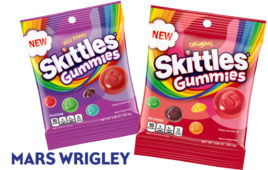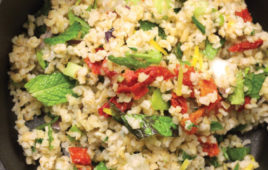From smaller bites to meatless products, find out what customers are demanding from snacks in 2019.
2019 is set to welcome big innovation for the snacks category as it carries forward the momentum from 2018.
2018 was a big year for the snack industry. Consumers are becoming less loyal to the big, established brands and instead reaching for smaller, emerging CPG options in higher percentages. This shift will continue in 2019, particularly when it comes to innovative products. Even with that innovation though, flavor is still the most important criteria for brand loyalty. And we’re seeing a return to taste, especially for the growing “Millennial mindset” audience who are searching for bolder flavors, according to Truly Good Foods’ recently released yearly Snack Food Trends report for 2019.
Some trends to watch in 2019 include:
Lil’ Snacks
Good things do indeed come in small packages when it comes to snacks. Consumers are looking for smaller grab-n-go items, preferably one serving. Manufacturers are responding to this demand with smaller 1-2-ounce snacks that still offer big taste. The littlest consumers – kids – are also having an impact on snack innovation. We’re seeing healthier versions of traditional kid snacks and also some innovative flavors sized down. It’s a huge buying audience that is prime for cleaner, more interesting snack options.
Hometown Flavor
Foods influenced by regions across the country are bringing flavor and nostalgia nationwide. From Chesapeake Bay spice to Nashville hot chicken to pimento cheese, these regional flavors are being incorporated into snacks. It’s a celebration of America’s culinary heritage and will continue to spread to more local and regional tastes.
Food Chain
While transparency continues to be an important consumer driver, traceability is a key part to this. Beyond transparent labels, consumers want to see all aspects of the supply chain and how a product went from farm to table. Expect to hear a lot more about blockchain in the coming year. Simply put, blockchain is a digital ledger and record of all data along the supply chain. For the food industry, the promise of blockchain provides a way for enabled consumers to trace the source and path of the products they are considering buying. Although its promise is huge, right now it’s not much more than hype so stay tuned.
Motherless Meat
One of the biggest recent trends will continue to grow this year. Meatless options continue their rise to mainstream with 8 in 10 millennials regularly consuming meatless alternatives. Food scientists are rapidly developing more non-meat options or as industry insiders refer to them: “motherless meat”. And if thinking about meat with that term doesn’t push you over to more plant-based diet, I don’t know what will.
In addition to free-from meat products, more companies are expanding other “free-from” foods than ever. These can include allergens, dairy, eggs and gluten.
Dining Pop Ups
With food becoming less about sustenance and more about the experience, dining times are no longer contained to restaurants. From more and more retail stores offering cafes, movie theaters featuring full menus and pop-up experiences like The Museum of Ice Cream, consumers have more opportunities than ever to have unique food experiences. Supermarkets are feeling the shift and creating custom food interactions for their customers with wine bars in store and a personalized experience with build-your-own trail mix bars.
Gut Punch
Medical studies show that a healthy gut is the foundation of overall wellness, and more than ever before, consumers are seeking foods that support their healthy immune systems. While kombucha continues to become more mainstream, expect to see more snacks that tout a richness of probiotics— good bacteria—and flavor.
Natural Enhancements
Functional foods are still very much on trend. Think natural remedy ingredients like turmeric for auto-immune inflammatory and enhancement ingredients like collagen for beauty, cannabis (CBD) for relaxation and karkade (hibiscus tea) for stress relief.
With processed food having a bad reputation as being unhealthy, consumers are also turning to “naturally” processed. More new products are featuring terms like sprouted, raw, cold-brew, charcoal-filtered, and steam-distilled.
Food Swaps
Cauliflower pizza crust, zucchini noodles, broccoli rice and chickpea crisps are all examples of products that were created by a food swap in which an unhealthy component was replaced by a more nutritious ingredient. Cauliflower continues to be the king of the food swap. A gluten-free alternative, customers love the cauliflower craze as it’s a lower carb vegetable that holds up like a grain and absorbs flavor easily. For the most part, it can replace starches in many classic foods without too much of a taste change, including pizza crust, rice, crackers and pretzels.
Why So Bitter?
Sour was the most recent flavor profile to have its moment in the sun and it looks like it’s finally bitter’s turn. As we continue to see a general aversion to sugar from consumers, bitter is coming to the forefront. It’s been seen in beverages with the explosion of craft beers these past few years, the popularity of green tea and the most recent cocktail du jour – the Aperol Spritz. Food is where this flavor profile will see growth in the coming year with more dark chocolate featured in snacks, green tea and matcha being added to snacks for a caffeine boost, vinegar-based products and cruciferous vegetables on menus.




